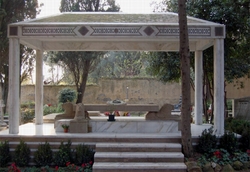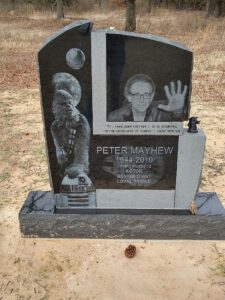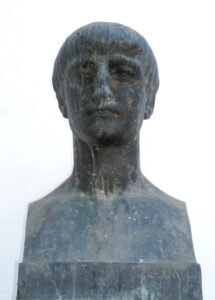
Modern bust of Lucan in Córdoba. There are no ancient likenesses.
On this day in 65 AD, Roman poet Lucan died by suicide by opening a vein at the age of 25, but not before incriminating his mother, among others, in the conspiracy of Gaius Calpurnius Piso against Nero, in the hopes of a pardon. According to Tacitus, as Lucan bled to death, “(he) recalled some poetry he had composed in which he had told the story of a wounded soldier dying a similar kind of death and he recited the very lines. These were his last words.” An alternative interpretation of events is that his death was not by suicide, but was an execution carried out at Nero’s command. Born Marcus Annaeus Lucanus on 3 November 39 AD in Corduba (modern-day Córdoba), in Hispania Baetica. He is regarded as one of the outstanding figures of the Imperial Latin period, known in particular for his epic Pharsalia. His youth and speed of composition set him apart from other poets.
Pharsalia
Aut nihil est sensus animis a morte relictum
aut mors ipsa nihil.
- Either no feeling remains to the soul after death, or death itself matters not at all.
- Book III, line 39
Vita brevis nulli superest qui tempus in illa
quaerendae sibi mortis habet.
- No life is short that gives a man time to slay himself.
- Book IV, line 478
Libera fortunae mors est; capit omnia tellus
quae genuit; caelo tegitur qui non habet urnam.
- The dead are free from Fortune; Mother Earth has room for all her children, and he who lacks an urn has the sky to cover him.
- Book VII, line 818
Scire mori sors prima viris, sed proxima cogi.
- Best gift of all
The knowledge how to die; next, death compelled. - Book IX, line 211
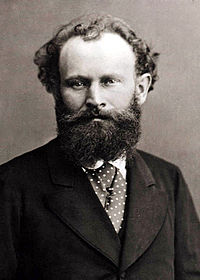 On this day in 1883, painter Édouard Manet died from complications of syphilis in Paris at the age of 51. Born in Paris on 23 January 1832, in his families ancestral hôtel particulier on the rue Bonaparte. Manet was one of the first 19th-century artists to paint modern life, and, in my opinion, a pivotal figure in the transition from Realism to Impressionism. His early masterworks, The Luncheon on the Grass (Le déjeuner sur l’herbe) (see below right) and Olympia, (see below left) both 1863, caused great controversy and served as rallying points for the young painters who would create Impressionism. Today, these are considered watershed paintings that mark the genesis of modern art. After the death of his father in 1862, Manet married Suzanne
On this day in 1883, painter Édouard Manet died from complications of syphilis in Paris at the age of 51. Born in Paris on 23 January 1832, in his families ancestral hôtel particulier on the rue Bonaparte. Manet was one of the first 19th-century artists to paint modern life, and, in my opinion, a pivotal figure in the transition from Realism to Impressionism. His early masterworks, The Luncheon on the Grass (Le déjeuner sur l’herbe) (see below right) and Olympia, (see below left) both 1863, caused great controversy and served as rallying points for the young painters who would create Impressionism. Today, these are considered watershed paintings that mark the genesis of modern art. After the death of his father in 1862, Manet married Suzanne 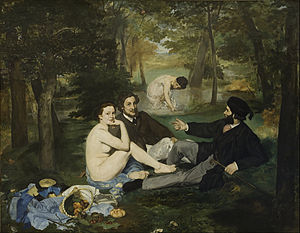 Leenhoff in 1863. Leenhoff was a Dutch-born piano teacher of Manet’s age with whom he had been romantically involved for approximately ten years. Leenhoff initially had been employed by Manet’s father, Auguste, to teach Manet and his younger brother piano. She also may have been Auguste’s mistress. In 1852, Leenhoff gave birth, out of wedlock, to a son, Leon Koella Leenhoff. Eleven-year-old Leon Leenhoff,
Leenhoff in 1863. Leenhoff was a Dutch-born piano teacher of Manet’s age with whom he had been romantically involved for approximately ten years. Leenhoff initially had been employed by Manet’s father, Auguste, to teach Manet and his younger brother piano. She also may have been Auguste’s mistress. In 1852, Leenhoff gave birth, out of wedlock, to a son, Leon Koella Leenhoff. Eleven-year-old Leon Leenhoff, 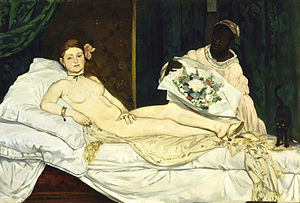 whose father may have been either of the Manets, posed often for Manet, most famously, as the subject of the Boy Carrying a Sword of 1861 (Metropolitan Museum of Art, New York). He also appears as the boy carrying a tray in the background of The Balcony. Manet painted his wife in The Reading, among other paintings.
whose father may have been either of the Manets, posed often for Manet, most famously, as the subject of the Boy Carrying a Sword of 1861 (Metropolitan Museum of Art, New York). He also appears as the boy carrying a tray in the background of The Balcony. Manet painted his wife in The Reading, among other paintings.
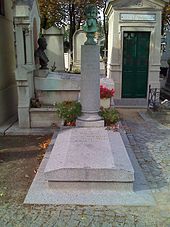 The Final Footprint – Manet is buried in Passy Cemetery in the 16th arrondissement of Paris. Opened in 1820 in the expensive residential and commercial districts of the Right Bank near the Champs-Élysées, by 1874 the small Passy Cemetery had become the aristocratic necropolis of Paris. Sheltered by a bower of chestnut trees, the cemetery is in the shadow of the Eiffel Tower. The retaining wall of the cemetery is adorned with a bas relief (by Louis Janthial) commemorating the soldiers who fell in the Great War. Other notable final footprints as Passy include; Claude Debussy, Gabriel Fauré, Hubert de Givenchy, Octave Mirbeau, and Berthe Morisot.
The Final Footprint – Manet is buried in Passy Cemetery in the 16th arrondissement of Paris. Opened in 1820 in the expensive residential and commercial districts of the Right Bank near the Champs-Élysées, by 1874 the small Passy Cemetery had become the aristocratic necropolis of Paris. Sheltered by a bower of chestnut trees, the cemetery is in the shadow of the Eiffel Tower. The retaining wall of the cemetery is adorned with a bas relief (by Louis Janthial) commemorating the soldiers who fell in the Great War. Other notable final footprints as Passy include; Claude Debussy, Gabriel Fauré, Hubert de Givenchy, Octave Mirbeau, and Berthe Morisot.
Gallery
-
-

The Spanish Singer, Metropolitan Museum of Art, 1860
-
-

The Old Musician, National Gallery of Art, 1862
-
Mlle. Victorine in the Costume of a Matador, Metropolitan Museum of Art, 1862
-
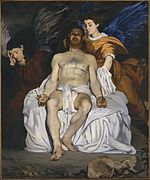
The Dead Christ with Angels, 1864
-

Battle of the Kearsarge and the Alabama, Philadelphia Museum of Art, 1864. Inspired by the Battle of Cherbourg (1864)
-
 Dead Matador, National Gallery of Art, 1864–1865
Dead Matador, National Gallery of Art, 1864–1865
-

The Philosopher, (Beggar with Oysters), Art Institute of Chicago, 1864–1867
-

The Ragpicker, Norton Simon Museum, 1865-1870
-
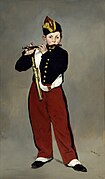
Young Flautist, or The Fifer, Musée d’Orsay, 1866
-
Still Life with Melon and Peaches, National Gallery of Art, 1866
-
The Tragic Actor (Rouvière as Hamlet), National Gallery of Art, 1866
-

Woman with Parrot, Metropolitan Museum of Art, 1866
-

Portrait of Madame Brunet, J. Paul Getty Museum, 1867
-

Execution of Emperor Maximilian, 1868
-

Portrait of Émile Zola, Musée d’Orsay, 1868
-

Breakfast in the Studio (the Black Jacket), New Pinakothek, Munich, Germany, 1868
-
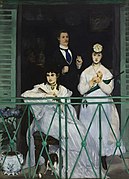
The Balcony, Musée d’Orsay, 1868–1869
-

Boating, Metropolitan Museum of Art, 1874
-

The grand canal of Venice (Blue Venice), Shelburne Museum, 1875
-

Madame Manet, Norton Simon Museum, 1874-1876
-

Portrait of Stéphane Mallarmé, Musée d’Orsay, 1876
-

Nana, 1877
-

The Rue Mosnier with Flags, J. Paul Getty Museum, 1878
-
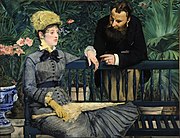
In the Conservatory, National Gallery, Berlin, Germany, 1879
-
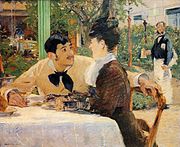
Chez le père Lathuille, 1879, Musée des Beaux-Arts Tournai
-

The Bugler, 1882, Dallas Museum of Art
-

House in Rueil, National Gallery of Victoria, Melbourne, Australia 1882
-

Garden Path in Rueil, Musée des Beaux-Arts de Dijon, 1882
-

Flowers in a Crystal Vase, National Gallery of Art, 1882
#RIP #OTD in 1926 civil aviator, the first African-American woman and first Native American to hold a pilot license, Queen Bess, Brave Bessie, Bessie Coleman died in a plane crash in Jacksonville, Florida, aged 34. Lincoln Cemetery, Cook County, Illinois
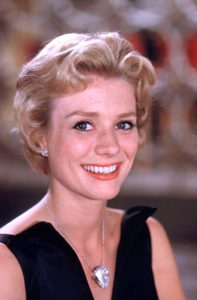 On this day in 1970 actress Inger Stevens died from a drug related overdose in Hollywood at the age of 35. Born Ingrid Stensland on October 18, 1934 in Stockholm.
On this day in 1970 actress Inger Stevens died from a drug related overdose in Hollywood at the age of 35. Born Ingrid Stensland on October 18, 1934 in Stockholm.
When she was nine, her mother abandoned the family and her father moved to the United States, leaving Inger and her sister in the custody first of the family maid and then with an aunt in Lidingö, near Stockholm. In 1944, the girls moved with their father and his new wife to New York City, where he had found work teaching at Columbia University. At age 13, she and her father moved to Manhattan, Kansas, where she attended Manhattan High School. At 16, she ran away from home to Kansas City, Missouri, and worked in burlesque shows. At 18, she left Kansas to return to New York City, where she worked as a chorus girl and in the Garment District while taking classes at the Actors Studio.

Stevens appeared in several films: A Guide for the Married Man (1967), with Walter Matthau; Hang ‘Em High, with Clint Eastwood; 5 Card Stud, with Dean Martin and Robert Mitchum; and Madigan with Henry Fonda and Richard Widmark.
Her first husband was her agent, Anthony Soglio, to whom she was married from 1955 to 1957.
After her death, actor Ike Jones claimed that he had been secretly married to Stevens since 1961. Some doubted this due to the lack of a marriage license, the maintaining of separate homes and the filing of tax documents as single people. However, at the time Stevens’ estate was being settled, the actress’s brother, Carl O. Stensland, confirmed in court that his sister had hidden her marriage to Jones “out of fear for her career”, because Jones was black. Los Angeles Superior Court Commissioner A. Edward Nichols ruled in Ike Jones’s favor and made him administrator of her estate. A photo exists of the two attending a banquet together in 1968. Her website also states that the marriage to Jones took place in Tijuana, Mexico.
The Final Footprint
Stevens cremated remains were scattered in the Pacific.
#RIP #OTD in 1974, actress (The Magnificent Ambersons, Mrs. Parkington, Johnny Belinda, Hush…Hush, Sweet Charlotte, Bewitched) Agnes Moorehead died of uterine cancer in Rochester, Minnesota, aged 73. Dayton Memorial Park in Dayton, Ohio
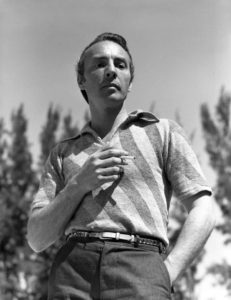 On this day in 1983, ballet choreographer George Balanchine died, aged 79, in Manhattan from Creutzfeldt–Jakob disease. Born Georgiy Melitonovich Balanchivadze on January 22, 1904 in Saint Petersburg, Russian Empire. In my opinion, one of the most influential 20th century choreographers. Styled as the father of American ballet, he co-founded the New York City Ballet and remained its Artistic Director for more than 35 years.
On this day in 1983, ballet choreographer George Balanchine died, aged 79, in Manhattan from Creutzfeldt–Jakob disease. Born Georgiy Melitonovich Balanchivadze on January 22, 1904 in Saint Petersburg, Russian Empire. In my opinion, one of the most influential 20th century choreographers. Styled as the father of American ballet, he co-founded the New York City Ballet and remained its Artistic Director for more than 35 years.
Balanchine took the standards and technique from his time at the Imperial Ballet School and fused it with other schools of movement that he had adopted during his tenure on Broadway and in Hollywood, creating his signature “neoclassical style”.
He was a choreographer known for his musicality; he expressed music with dance and worked extensively with leading composers of his time like Igor Stravinsky. Balanchine was invited to America in 1933 by a young arts patron named Lincoln Kirstein, and together they founded the School of American Ballet. Along with Kirstein, Balanchine also co-founded the New York City Ballet (NYCB).
In 1923, Balanchine married Tamara Geva, a sixteen-year-old dancer. After his divorce from Geva, Balanchine was partnered with Alexandra Danilova from 1926 through 1933. He married and divorced three more times, all to women who were his dancers: Vera Zorina (1938–1946), Maria Tallchief (1946–1952), and Tanaquil LeClercq (1952–1969). He had no children by any of his marriages and no known offspring from any extramarital unions or other liaisons.
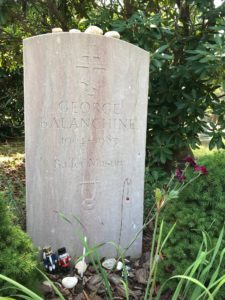
The Final Footprint
The night of his death, the company went on with its scheduled performance, which included Divertimento No. 15 and Symphony in C at Lincoln Center.
He had a Russian Orthodox funeral, and was interred at the Oakland Cemetery at Sag Harbor, Suffolk County, New York at the same cemetery where Danilova was later interred.
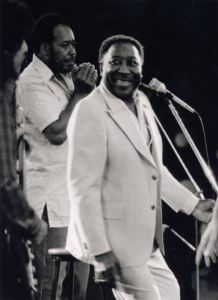 On this day in 1983, blues musician, The Father of Chicago Blues, Muddy Waters died in his sleep from heart failure at his home in Westmont, Illinois at the age of 70. Born McKinley Morganfield on April 4, 1913 in Issaquena County, Mississippi.
On this day in 1983, blues musician, The Father of Chicago Blues, Muddy Waters died in his sleep from heart failure at his home in Westmont, Illinois at the age of 70. Born McKinley Morganfield on April 4, 1913 in Issaquena County, Mississippi.
Muddy Waters grew up on Stovall Plantation near Clarksdale, Mississippi, and by age 17 was playing the guitar and the harmonica, emulating the local blues artists Son House and Robert Johnson. He was recorded in Mississippi by Alan Lomax for the Library of Congress in 1941. In 1943, he moved to Chicago to become a full-time professional musician. In 1946, he recorded his first records for Columbia Records and then for Aristocrat Records, a newly formed label run by the brothers Leonard and Phil Chess.
In the early 1950s, Muddy Waters and his band—Little Walter Jacobs on harmonica, Jimmy Rogers on guitar, Elgin Evans on drums and Otis Spann on piano—recorded several blues classics, some with the bassist and songwriter Willie Dixon. These songs included “Hoochie Coochie Man”, “I Just Want to Make Love to You” and “I’m Ready”. In 1958, he traveled to England, laying the foundations of the resurgence of interest in the blues there. His performance at the Newport Jazz Festival in 1960 was recorded and released as his first live album, At Newport 1960.
Muddy Waters’ influence was tremendous, not just on blues and rhythm and blues but on rock and roll, hard rock, folk music, jazz, and country music. His use of amplification is often cited as the link between Delta blues and rock and roll.
Waters’s longtime wife, Geneva (a first cousin of R. L. Burnside), died of cancer on March 15, 1973. Gaining custody of some of his children, he moved them into his home, eventually buying a new house in Westmont, Illinois. Years later, he travelled to Florida and met his future wife, 19-year-old Marva Jean Brooks, whom he nicknamed “Sunshine”. Eric Clapton served as best man at their wedding in 1979.
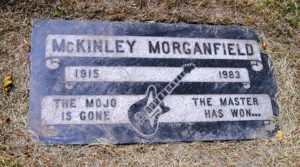
The Final Footprint
Throngs of blues musicians and fans attended his funeral at Restvale Cemetery in Alsip, Illinois, to pay tribute.
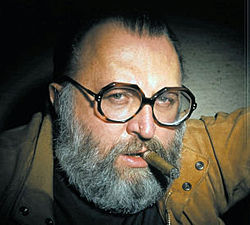 On this day in 1989, director, producer and screenwriter, Sergio Leone died from a heart attack in Rome at the age of 60. Born on 3 January 1929 in Rome. Best known as the director of three legendary, iconic westerns, often referred to as Spaghetti Westerns: A Fistful of Dollars (Per un pugno di dollari) (1964) with Clint Eastwood; For a Few Dollars More (Per qualche dollaro in più) (1965) with Eastwood and Lee Van Cleef; and The Good, the Bad and the Ugly (Il buono, il brutto, il cattivo) (1966) with Eastwood, Van Cleef and Eli Wallach. The film score for all three movies was composed by Ennio Morricone. Leone also directed Once Upon a Time in the West (C’era una volta il West) (1968) with Henry Fonda, Charles Bronson, Jason Robards and Claudia Cardinale; and Once Upon a Time in America (C’era una volta il America) (1984) with Robert De Niro. All five of these movies are among my very favorites and I will stop what I am doing to watch them.
On this day in 1989, director, producer and screenwriter, Sergio Leone died from a heart attack in Rome at the age of 60. Born on 3 January 1929 in Rome. Best known as the director of three legendary, iconic westerns, often referred to as Spaghetti Westerns: A Fistful of Dollars (Per un pugno di dollari) (1964) with Clint Eastwood; For a Few Dollars More (Per qualche dollaro in più) (1965) with Eastwood and Lee Van Cleef; and The Good, the Bad and the Ugly (Il buono, il brutto, il cattivo) (1966) with Eastwood, Van Cleef and Eli Wallach. The film score for all three movies was composed by Ennio Morricone. Leone also directed Once Upon a Time in the West (C’era una volta il West) (1968) with Henry Fonda, Charles Bronson, Jason Robards and Claudia Cardinale; and Once Upon a Time in America (C’era una volta il America) (1984) with Robert De Niro. All five of these movies are among my very favorites and I will stop what I am doing to watch them.
The Final Footprint – Leone is interred in a private estate in Cimitero di Pratica di Mare in Pratica di Mare, Lazio, Italy.
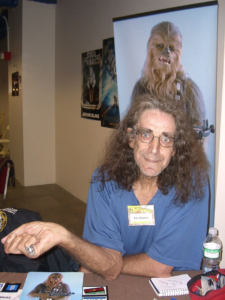 On this day in 2019, actor Peter Mayhew died of a heart attack at his home in Boyd, Texas, age 74. Born Peter William Mayhew on May 19, 1944 in Barnes, Surrey, England. Perhaps best known for portraying Chewbacca in the Star Wars film series. He played the character from the 1977 original to 2015’s The Force Awakens before his retirement from the role. His height 7′ 2″, was a product of Marfan syndrome.
On this day in 2019, actor Peter Mayhew died of a heart attack at his home in Boyd, Texas, age 74. Born Peter William Mayhew on May 19, 1944 in Barnes, Surrey, England. Perhaps best known for portraying Chewbacca in the Star Wars film series. He played the character from the 1977 original to 2015’s The Force Awakens before his retirement from the role. His height 7′ 2″, was a product of Marfan syndrome.
Mayhew married Mary Angelique “Angie” Luker (née Cigainero; born October 12, 1954), a native of Texas, on August 7, 1999. The two lived in Boyd, Texas.
He became a naturalised citizen of the United States in 2005 at a ceremony in Arlington, Texas. In an interview with the Fort Worth Star-Telegram he joked that he did not get a medal at this ceremony either, a reference to the closing scene in Star Wars during which Luke Skywalker and Han Solo get medals, but Chewbacca does not. Mayhew noted in an MTV interview that although Chewbacca does not get a medal in the film, he does have the last line of dialogue, when he roars.
The Final Footprint
He was buried in Reno, Parker County, Texas, in Azleland Memorial Park and Mausoleum.
Star Wars: The Rise of Skywalker is dedicated to his memory.
#RIP #OTD in 2022, singer, with her daughter Wynonna The Judds (“Mama He’s Crazy”, “Why Not Me”, “Girls Night Out”, “Love Is Alive”) mother of Ashley, Naomi Judd died from a self-inflicted gunshot wound at her home in Leiper’s Fork, Tennessee, aged 76.
Have you planned yours yet?
Follow TFF on twitter @RIPTFF




